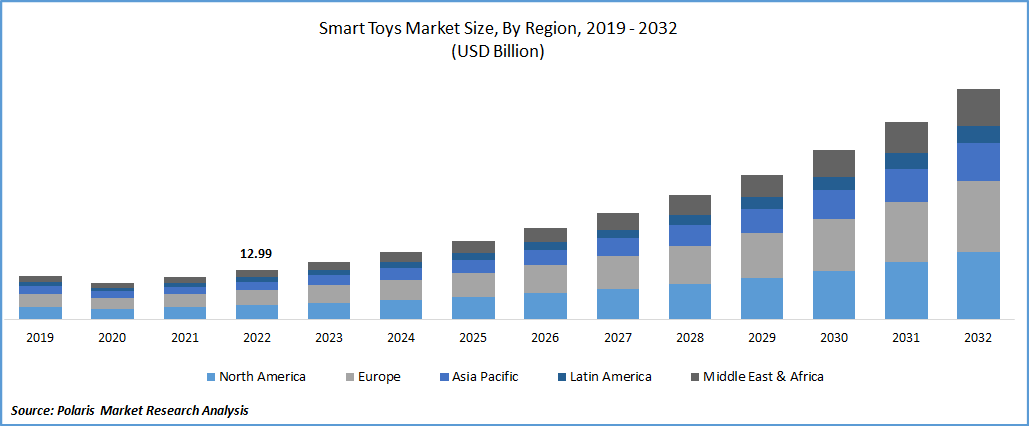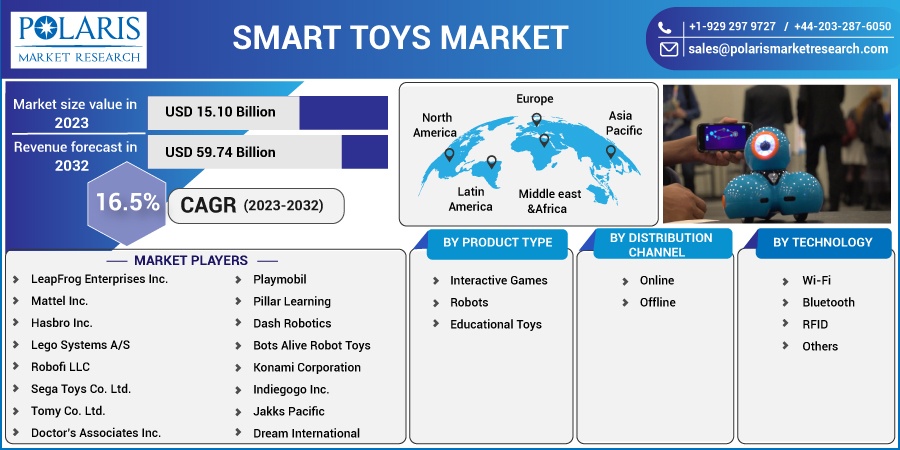
Smart Toys Market Share, Size, Trends, Industry Analysis Report
By Product Type (Interactive Games, Robots, and Educational Toys); By Distribution Channel; By Technology; By Region; Segment Forecast, 2023-2032
- Published Date:Jan-2023
- Pages: 119
- Format: PDF
- Report ID: PM2969
- Base Year: 2022
- Historical Data: 2019-2021
Report Outlook
The global smart toys market was valued at USD 12.99 billion in 2022 and is expected to grow at a CAGR of 16.5% during the forecast period.
The rise in the utilization of smart toys across the globe in order to enhance and improve children learning and critical thinking abilities along with the launch of several smart toys in novel shapes and patterns to gain the attention of children by key market manufacturers are driving the growth of the global market. Moreover, the increasing consumer awareness of the benefits of these toys through social media platforms and smartphones is encouraging consumers to opt for technology-led toys, and pushing the market growth forward.

Know more about this report: Request for sample pages
Furthermore, increasing prevalence and penetration of STEM toys for children’s skill enhancement including coding and engineering through smart interaction and advanced behavioral learning coupled with its capabilities to provide personalized play experience with the help of embedded software offering image recognition, RFID functionality, and app integration are likely to impact the market growth positively over the coming years.
However, spending excess time with toys and games, may affect their concentration level and obstruct their academic results is a major factor restraining the growth of the global market over the anticipated period. Moreover, excessive spending of time on gadgets might impact their thinking capacity owing to the lack of exposure.
The COVID-19 pandemic has impacted the adoption of smart toys. The rapid outbreak of the deadly virus has resulted in lockdowns & restrictions on trade activities and high disruptions in the global supply chain and accounts for a slight decline in the sales and demand of smart toys. However, the support of various social media platforms and the high influence of media and TV pushed market growth forward during the pandemic.
 Know more about this report: Request for sample pages
Know more about this report: Request for sample pages
Industry Dynamics
Growth Drivers
The rapidly increasing consumer disposable income especially in developed economies such as the U.S., U.K., France, and Japan, and the surge in adoption of technologies like Smart Homes, Connected Mobile Devices, AR, and VR are key factors boosting the growth of the global smart toys market. In addition, virtual reality technologies are encouraging and helping children to build their imagination and improve their thinking skills with real-world simulations, which has further fueled the market growth.
Furthermore, in recent years, online sales have gained high traction with the evolution of digital media and the growing penetration of smartphones across the globe and mainly in emerging economies like India and China are driving market growth significantly. A wide range of benefits offered by online shopping platforms including the availability of a variety of brands, no need for bargaining, free home delivery, and easy price comparison on different platforms are augmenting the market growth.
Report Segmentation
The market is primarily segmented based on product type, distribution channel, technology, and region.
|
By Product Type |
By Distribution Channel |
By Technology |
By Region |
|
|
|
|
Know more about this report: Request for sample pages
Interactive games segment accounted for the largest market share
The interactive games segment accounted for a considerable global market share in 2022 and is likely to grow considerably over the projected period owing to rapid growth in smartphone penetration and the extensive rise of edutainment services. Interactive games are an effective and fun way to explore new creative skills and knowledge and can be used for learning letters and alphabets in the preschool phase, which drives the segment market growth.
Moreover, the education toys segment is expected to register the fastest growth throughout the anticipated period. Smart education toys are very helpful and effective for boosting problem-solving ability, teamwork, communication skills, and creativity among kids and children, which are key factors influencing the growth of the segment market. In addition, these types of robots are normally operated with the help of a smartphone or tablet and can be controlled easily from anywhere, which is propelling the adoption of educational toys.
Offline segment held a significant market revenue share in 2022
The offline segment led the industry with a holding of significant market revenue share in 2022 owing to the option for checking the working and quality of toys physically and the easy availability of retail stores across all the regions. Additionally, increasing efforts and focus by key market players on expanding their presence by opening new specialty and retail stores along with the rapid increase in government initiatives to support new and effective ways of learning and skill enhancing fueling the market segment growth.
However, the online segment is projected to witness the highest growth during the anticipated period on account of the rapid emergence of various online shopping platforms and increased number of smartphone users, and growing penetration for fast internet facilities among them. The availability of smart toys on online channels enables market players to diversify their consumer base by promoting and advertising their products through TV, electronic media, and social media platforms.
Bluetooth segment dominated the global market with the largest revenue share
The Bluetooth segment garnered the majority of the share. This is primarily due to the high adoption of medium-segment tablets and smartphones across various developing countries including India, China, Brazil, and South Korea. Bluetooth usually holds nearly unmatched potential for toy designing, as it helps and enables seamless control between toys and mobile applications and close-range connection.
Moreover, availability of a wide range of smart toys in the market offering advanced technologies like app integration, voice or image recognition, and RFID functionality, Bluetooth has become a stalwart of technologically advanced toys, as it has a high potential to serve effectively as the foundation of the next generation interactive toys.
The demand in Asia Pacific is expected to witness significant growth
The Asia Pacific region is expected to emerge fastest at a growth rate during the forecast period. The growth of the regional market is mainly driven by an extensive rise in the middle-class population and growing consumer preferences for smart educational toys along with the high efforts by key market companies on introducing new and innovative toys to cater to the rising consumer demand. The emerging trend of digitalization and investments in research and development activities are likely to contribute significantly to the demand and adoption of smart toys in the region.
North America accounted for the largest share, in 2022, which is accelerated by increased adoption of smart home devices and growing consumer purchasing power in countries like the United States & Canada. Also, the rapid surge in the usage of the internet on smart toys or devices and the wide presence of large vendors, who are increasingly adopting innovative and advanced technologies to create products as per consumer needs and requirements, are expected to boost the market growth in the near future.
Competitive Insight
Some of the major players operating in the global market include LeapFrog Enterprises, Mattel, Hasbro, Lego Systems, Robofi LLC, Sega Toys., Tomy Co., Doctor’s Associates, Playmobil, Pillar Learning, Dash Robotics, Bots Alive Robot Toys, Konami Corporation, Indiegogo, Jakks Pacific, and Dream International
Recent Developments
In July 2022, Smart Toys and Games, a leading Belgian puzzles and games company announced its latest acquisition of The Happy Puzzle Company. With this acquisition, the company will expand its product portfolio by bringing The Happy Puzzle Company products and will spread its distribution through SMART’s exclusive worldwide network.
Smart Toys Market Report Scope
|
Report Attributes |
Details |
|
Market size value in 2023 |
USD 15.10 billion |
|
Revenue forecast in 2032 |
USD 59.74 billion |
|
CAGR |
16.5% from 2023 – 2032 |
|
Base year |
2022 |
|
Historical data |
2019 – 2021 |
|
Forecast period |
2023 – 2032 |
|
Quantitative units |
Revenue in USD billion and CAGR from 2023 to 2032 |
|
Segments Covered |
By Product Type, By Distribution Channel, By Technology, By Region |
|
Regional scope |
North America, Europe, Asia Pacific, Latin America; Middle East & Africa |
|
Key Companies |
LeapFrog Enterprises Inc., Mattel Inc., Hasbro Inc., Lego Systems A/S, Robofi LLC, Sega Toys Co. Ltd., Tomy Co. Ltd., Doctor’s Associates Inc., Playmobil, Pillar Learning, Dash Robotics, Bots Alive Robot Toys, Konami Corporation, Indiegogo Inc., Jakks Pacific, and Dream International |
FAQ's
key segments are product type, distribution channel, technology, and region.
Smart Toys Market Size Worth $59.74 Billion By 2032.
The global smart toys market expected to grow at a CAGR of 16.5% during the forecast period.
Asia Pacific is leading the global market.
key driving factors are Growing adoption of education-based toys and Rising adoption of AI and IoT technology.
